The Estates – Mean Real Estate Development – and I Love It!
Introduction
Note: This review was first published on Zatu on 30th January 2019.
Having a large game collection often means that I tend to only play games once or twice – crazy I know but that’s how I roll. Every so often a new game arrives that breaks the pattern. Once such game is The Estates, a game designed by Klaus Zoch and published by Capstone Games. In fact, The Estates is a reimplementation of the 2007 game Neue Heimat (New Home) by the same designer.
The Estates Kickstarter arrived in early November 2018 and I have already played it more than 10 times. In fact, most people who have played it with me immediately want to play it again after finishing their first play.
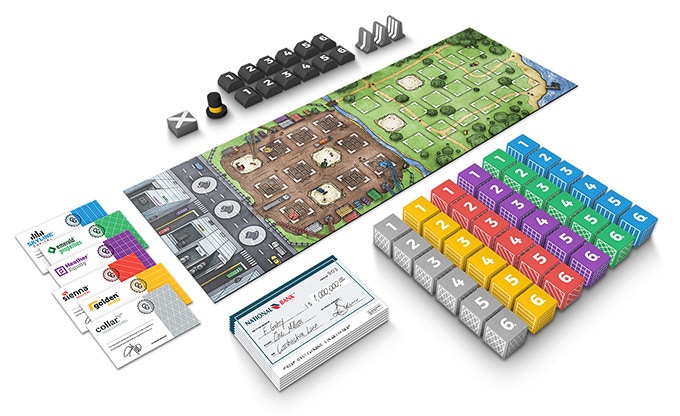
Game Information
The game is for 2-5 players aged 10 and above and I would say that 4 players is probably best. The game is excellent at all player counts with the strategy and tactics changing accordingly. The game is supposed to take approximately an hour although I have played games lasting nearly two hours. The game is fairly lightweight and easy to teach and play, yet there is a surprising amount of depth, strategy and tactics. The game has a reasonably small footprint – it can be played on a small table.
Overview
In the Estates players take on the role of real estate investors hoping to make a profit by constructing buildings in a new development recently approved by the City Council. The council approved a construction site consisting of two rows of up to 4 buildings on one side of a river – the developers spot an opportunity and attempt to build three rows.
Unfortunately, not all building plots are the same as five of the plots are built on sand (white background) meaning only a one-story buildings can be built on those plots. Additional building permits are available to build on the other side of the river, thus extending the number of buildings required to complete a row.
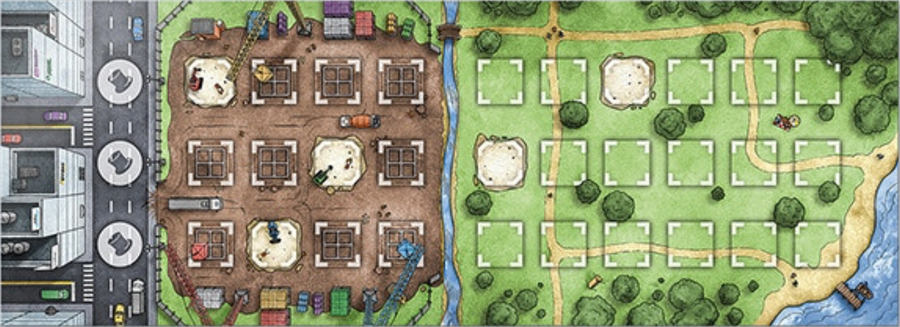
The city council will only pay out on completed rows meaning that every building on a row must have a roof on it. If two rows are successfully completed than the game ends – developers who have built on an incomplete row are penalised.
The City Mayor also wants to get in on the act and offers to double the profits on one of the rows if it is completed but also to double the penalties for not completing the row.
Components
The components are fantastic. The building blocks are solid and chunky, one nice touch is that each of the sixty ‘$1million’ cheques is made out to a different person (perhaps Kickstarter backers?) and the cardstock is thick. The six real estate Company Certificates match the different designs on the floor blocks which is great for people with a CVD (colour vision disability), thus enabling all players to easily identify the different blocks and companies.

One thing I really like is that the bag which holds all the blocks is big enough to fit my hand in easily – that isn’t always the case. The board is functional and well designed, but I think it would benefit from having a designated space to place the current item up for auction.
Set Up
Each of the six development companies has a set of 6 floor cubes numbered 1 to 6. The 36 floor cubes are placed in the bag. 24 of the cubes are then removed from the bag and placed in 3 rows of 8 within easy reach of the players. The remaining 12 blocks are not used. This does lead to a sort of variable setup but the key thing to note is the distribution of the colours of the cubes. It is possible to have, say, five or even six cubes of one company and maybe just one (or even none) of another.
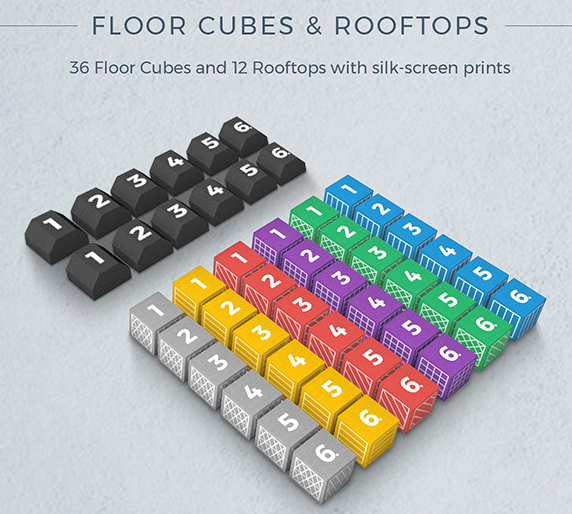
The 12 rooftops, 2 of each are numbered 1 to 6, are mixed up and placed face down on the table together with the three additional building permits, the single permit cancellation piece and the City Mayor piece.
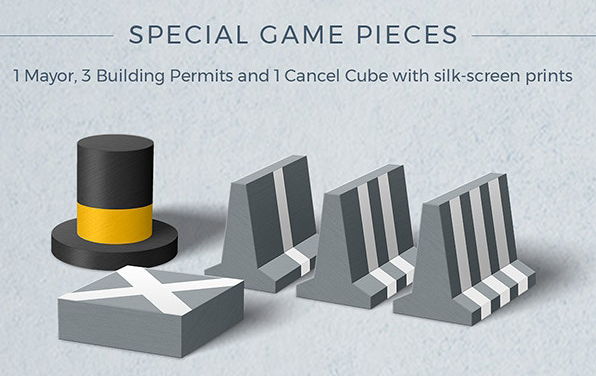
Each player is given $12 million as starting money – any leftover money is not used in the game and can therefore be put back in the box.
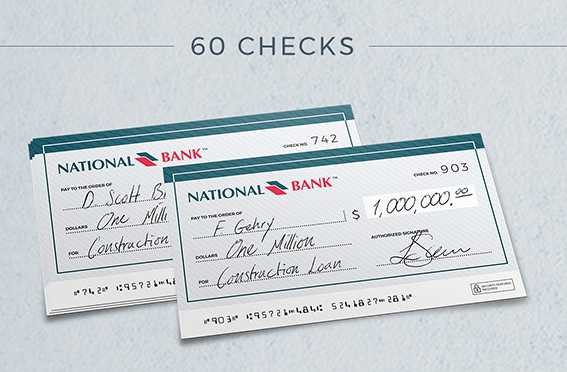
Game Play
The first player is randomly chosen and becomes the active player. The active player can put a single $1M cheque to one side as part of their slush fund at the start of each of their turns. At the end of the game money in the slush fund counts as 1VP per $1M whilst money in hand at the end of the game does NOT count towards final scoring.
The active player will then select one of the many wooden pieces—floor cube, rooftop, building permit, City Mayor, or cancel cube—and hold an auction for it. In the case of floor cubes only cubes at either end of each row may be selected which still gives a choice of six cubes. Each of the other players, in clockwise order, may bid once for the chosen piece or they can pass. Once everyone has had a chance to bid the highest bidder is determined which then gives the active player two options.
The first option is that the active player gives the selected piece to the highest bidder who then pays the winning bid to the active player OR the active player keeps the chosen piece and pays the winning bid to the highest bidder. If no-one bids the active players gets to keep the piece for free.
The player who won the auction must then place the piece on the game board if it was a floor block or a rooftop. If the piece was a building permit, the City Mayor or the cancel cube, it must either be placed immediately, or it can be discarded from the game.
If you are placing the first cube of a colour, then you also take the corresponding Company Certificate. You are allowed to own more than one Company Certificate or even none at all. If you don’t own any Company Certificates then your game plan is to try and make sure that none of the three building rows are completed, thus ensuring that all the other players get negative points whilst you win by putting money in your slush fund. This strategy can also lead to the other players working together to make sure one or more rows is completed.
Once a piece has been placed or discarded play passes to the next player who then becomes the active player.
Placement of Floor Blocks
Blocks must be placed starting to the right of the road. You can build next to an existing block but there cannot be any gaps in the row. You can build on top of an existing block, apart from the blocks built on sand, if the floor below is a higher number. The colour of the block doesn’t matter. For example, a green #5 is built on a plot. Any block with a lower number (not just a four) can be placed on top of the #5. A #1 block on a plot will automatically become the top block in a stack as you cannot get less than #1. You cannot place a block on top of a building that has a rooftop on it.
A row is complete if all the buildings on the row has a rooftop. Each row is limited to 4 lots in each row unless building permits have been used to extend (or shorten) the row.
Game End & Scoring
The game ends as soon as 2 rows of buildings are completed or if it is impossible to complete any more buildings because there are no more floor blocks or rooftops. Players will then earn positive or negative points based on where their building(s) is/are located within The Estates.
All buildings with floor cubes and rooftops in completed rows score positive points. All buildings with or without rooftops in uncompleted rows score negative points. The City Mayor doubles the score, positive or negative, for each building in his row.
A building scores points only for the player who holds the Company Certificate matching the colour of the topmost floor cube in a building. Each floor cube in the building scores points equal to the printed value on the cube. The value of the Rooftop is also added.
For example, in a building with a #4 green on the bottom, a #1 blue next in the stack, and a #3 roof on top. The blue player only scores 8VP (4+1+3) if the entire row was completed or -8VP if the row was incomplete. If the building was on the row with the mayor then the scores are doubled, both positive and negative meaning 16VP or -16VP.
Each cheque in your slush fund scores 1VP for you and the most VPs wins. It is possible for all players to finish up with negative points.
Strategy
Every auction is the result of a tricky decision. Which piece should I put up? How much should I bid? Do I even want to win the auction? Can I pick something that several other players want, thus leading to a bidding contest and inflating the price? Do I want to try the strategy where I don’t want any Company Certificates and try to sabotage the building efforts of the other players? Do I want to play a kind of semi-coop game with another developer to ensure a row gets completed?
Money management is also very important, especially at the beginning of the game. Do I put some in the slush fund, thus removing it from circulation, or save it for bidding?
These can be tough, strategic decisions and are a key element of the game – timing is often crucial.
Expansions & Variants
Currently there are no expansions or variants listed on BGG although I did try once with 6 players. That game was abandoned before it really got started so I can’t comment on whether it is good at that player count, but it should be perfectly playable. The only real difference from the standard setup in a 6-player game is that each player would only receive $10 million starting capital instead of $12 million.
Final Thoughts
The Estates is a fantastic game and I love playing it. The game is easy to play yet full of wonderful possibilities. It is one of my top 10 and likely to remain there for some time. I will always say yes to a game of The Estates.
The variable setup leads to increased replayability as players constantly try different tactics. There is a ton of player interaction as well.
All players are involved in the game all the time – there is no downtime which is quite unusual in a game. The various strategies ensure no two games are the same as players experiment with different strategies – there isn’t a dominant strategy in the game.
Money management is crucial. Do I put money in my slush fund, or will I keep it for bidding?
Choosing which item to put up for auction can be tricky as well. Do I pick something that I want or something I know an opponent wants and would be will be willing to pay good money for? As the game draws to a climax you may want to win a low numbered opponents block to place on top of one of your own blocks to ensure your block isn’t at the top of a stack when scoring occurs, especially if it is a double-negative score on an uncompleted row.
Players who don’t normally like ‘take that’ in games tend to enjoy the game because the meanness isn’t personal, it’s just a fun part of the game where, essentially, you have been out-manoeuvred by your opponents.
You might like
- Good at all player counts
- Different winning strategies but just the right amount of options on a turn
- Tons of player interaction – very little downtime
- Quick & easy to set up and put away
- Easy to learn, especially for gamers new to the hobby
- Variable setup
- Tense and exciting gameplay
You might not like
- Avoid if you don’t like mean games
- Other players potentially ganging up on you
- Forgetting to put money in the slush fund
- May be too light for some gamers
Overall Score – 95%
- Engagement 5
- Replayability 4
- Component Quality 5
- Player Interaction 5
© 2019 Mick Wood – The Lanky Gamer UK – mick@lankygamer.co.uk